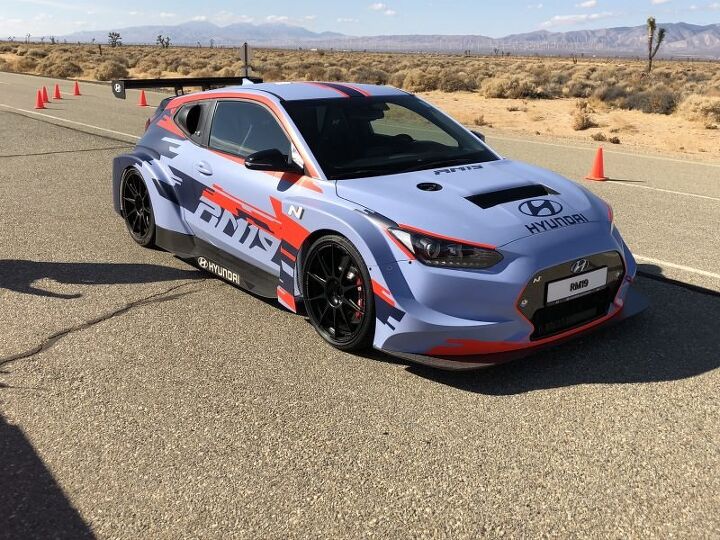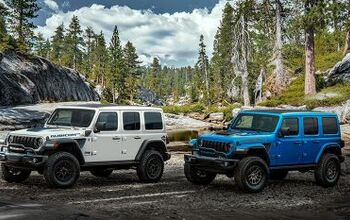Hyundai's RM19 Previews the Brand's Performance Future

I drove the racetrack-ready Hyundai RM19 prototype, and I didn’t crash it.
The day after the Los Angeles Auto Show, while most of the rest of the assembled automotive media was either at home or in an airplane heading that way, I was in a shuttle bus heading north from Westwood/Beverly Hills towards the desert. Awaiting me would be the RM19 high-performance version of the Hyundai Veloster N.
The bus was ferrying me to Hyundai’s Proving Grounds located in/near California City, California. In addition to driving the RM19, I’d autocross a production Veloster N against the clock – something I did on the launch last year, outside of Sacramento – and be offered the chance to ride right-seat with a pro driver on an autocross in a race-prepped Veloster N. I’d also get to off-road a Palisade SUV and take a Nexo fuel-cell crossover around the high-speed track.
I skipped the right-seat ride due to lack of time, and I have little to say about autocross or the off-road. Those were merely repeats of experiences I’ve had before. The story here is the RM19, which Hyundai claims is a preview of future N products.
That exact future isn’t yet clear.
(Full disclosure: Hyundai paid for my hotel room, meals, and return flight from Los Angeles so that I could attend this event).
Basically, the RM19 is a testbed. Hyundai’s media materials say it “signals future high-performance potential for Hyundai N brand,” with the RM19 serving “as a development platform for future N brand products, including a potential brand-halo car.” Translation: If the demand is there, this car could be built to compete with other track-ready production cars, and if it’s not built, well, the lessons learned could be applied to the N.
Hyundai’s sudden interest in performance is no coincidence, seeing as Albert Biermann, formerly of BMW, is now in charge of R&D.
The engine is moved to mid-ships on the RM19 (hence the RM part of the name, which stands for Racing Midship), and the Touring Car Racing-based 2.0-liter turbo four-cylinder makes “approximately” 390 horsepower (apparently tuned down to 360 for our test day. Overall, the car has a range of 320-390 horsepower). The rear-drive RM19 ditches the Veloster’s weird third door and adds a large rear wing and rear air ducts for the engine. Power gets to the rear wheels via a six-speed sequential manual transmission. Hyundai reps tried to track down a torque figure for me but were unable to send it over before press time.
Hyundai claims the top speed of over 155 mph when not limited for public-road driving. There’s a MacPherson suspension setup out front and a double-wishbone system out back; the brakes feature six-piston calipers up front and four-piston calipers in the rear, plus a special ABS system that can only be used on the track.
The power-steering unit is rack-mounted and motor-driven, and the tires (305 wide in the rear) sit upon lightweight forged aluminum-alloy wheels.
Tracking the car is quite the experience. Like with any race-prepped car, you need assistance getting belted in, thanks to the five-point racing harness. Hyundai set up a handful of chicanes on their handling loop to keep speeds down and to give us a chance to really dig into the brakes, while also accelerating out in second gear. We were also assigned a pro driver riding right seat for supervision and assistance. The gentleman I was paired with said nothing other than “chicane” (meaning “brake here”) for the chicanes on my warm-up lap. I assume his silence was a good thing.
Hyundai’s handling loop is flat, and being in the middle of the desert, it lacks visual references for braking and turn-in. Between that, and the fact that two other journos (one of whom is an accomplished racer) in my session looped the car before my turn (no sheetmetal was bent, but one tire was cut by some desert brush and needed to be replaced), I knew I’d likely be driving this car very conservatively.
Getting out of the pit was tricky – the sequential manual only requires you to use the clutch when stopping and starting, but the clutch is heavy and it’s easy to stall. I managed to get rolling with no drama, however.
The RM19’s paddle shifters provide instant shifts, and as you’d expect from a track car, gear changes are more raw than smooth. Acceleration is, unsurprisingly, swift, giving you a kick in the ass when you get on the gas.
I couldn’t tell you how fast I was going, since I never looked down at the dash (the car’s interior is pretty close to the standard N, but with some race-ready equipment, including a racing steering wheel that has all the necessary buttons and knobs). Given the car’s power and the length of the straights that weren’t coned off for the chicanes, I was probably hitting highway speeds and maybe flirting with triple digits – but maybe not, since I was being a bit cautious.
As you’d expect, turn-in is instant and direct, and the brakes bite hard. While this car is street legal in Europe and likely street legal in the U.S. (a Hyundai rep wasn’t sure), it’s essentially a racecar, and it has racecar reflexes. Not racecar-like, but straight-up racecar.
That also means you feel every single imperfection in the pavement, not that there are many on a private road in the middle of the desert that’s maintained by an automaker. The drive is exhilarating but exhausting, or at least it would be over a longer period of time. Three laps flies by too quickly.
With more time, I’d have built up more courage to push the car harder – I was already starting to settle into a groove as my session ended. Still, even driven relatively gently, I could sense the car’s performance potential.
That’s the keyword – potential. It’s highly unlikely that Hyundai would build a street version of this car, although a spokesman told me the idea isn’t off the table. He used the phrase “forms of production potential.” In other words, Hyundai could use the RM19 to simply work on a new engine or transmission, or they could build something streetable off this platform.
One powertrain possibility is an even more souped-up version of Hyundai’s 2.5-liter four-cylinder turbo and eight-speed dual-clutch automatic transmission combo found in the upcoming Sonata N Line. Hyundai also indicated that an electric motor could find its way underhood.
Whatever Hyundai has planned, it certainly didn’t pay for journalists to come all the way out to the desert for no reason. The autocross, the off-road, the rides with the pros, time with the Nexo – none of that, on its own, justifies a dip into the PR budget. No, we were there for the RM19, and not just because Hyundai wanted to give 30 journalists a chance to have fun with it. If Hyundai doesn’t have something in mind for this testbed, it wouldn’t spend the money for us to drive it.
I can brag all I want about hitting 111 mph on the high-speed oval in the Nexo – apparently, the highest speed Hyundai ever sees in that crossover on the loop, and not a speed achieved often – but that’s not why Hyundai brought me there. Nor did they bring me there just so I could drive a racing-ready car. No, the RM19 definitely previews the brand’s performance future.
That future is indeterminate. But if the brand comes up with something good based on the RM19 – whether a whole new car or just better performance from future iterations of the current lineup – I have no doubt it will be quite engaging to drive, at least based on what Hyundai has done with the RM. The brand may be known more for making commuter cars, but at the very least, it’s as capable of making good performance cars as anyone else.
The Veloster N has already shown that. The RM19 serves to further quell doubts.
[Images © 2019 Tim Healey/TTAC]

Tim Healey grew up around the auto-parts business and has always had a love for cars — his parents joke his first word was “‘Vette”. Despite this, he wanted to pursue a career in sports writing but he ended up falling semi-accidentally into the automotive-journalism industry, first at Consumer Guide Automotive and later at Web2Carz.com. He also worked as an industry analyst at Mintel Group and freelanced for About.com, CarFax, Vehix.com, High Gear Media, Torque News, FutureCar.com, Cars.com, among others, and of course Vertical Scope sites such as AutoGuide.com, Off-Road.com, and HybridCars.com. He’s an urbanite and as such, doesn’t need a daily driver, but if he had one, it would be compact, sporty, and have a manual transmission.
More by Tim Healey
Latest Car Reviews
Read moreLatest Product Reviews
Read moreRecent Comments
- Wjtinfwb I really like these, but can't shake the voice in my head that says, "$9000 will just be the starting point. You'll have 20 grand in this baby inside of 18 months".
- SCE to AUX I hope they're buying good lawyers, too.
- SCE to AUX Nothing to see here. Gas prices 2021-23 were the same as they were in 2007-2008, adjusted for inflation. The R's were in charge then.https://www.randomuseless.info/gasprice/gasprice.html
- VoGhost Just reminding us all that we have to tolerate dealers (many of whom are billionaires) in the US if we want new legacy ICE vehicles because the dealers pay for the campaigns of local politicians, with our money.
- 1995 SC I'm still trying to get past the fact that the Red Bull guy is married to a Spice Girl.









































Comments
Join the conversation
1979 Supra-311,000 miles (200k of those with BAE turbo) 2002 Xterra=460,000 miles
Hmm, like the old Renault Clio V6 Renault Sport (not a typo). A mid-engined RWD hot hatch based on the FWD hatch. https://en.wikipedia.org/wiki/Clio_V6_Renault_Sport